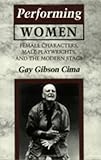Performing Women : Female Characters, Male Playwrights, and the Modern Stage / Gay Gibson Cima.
Material type: TextPublisher: Ithaca, NY : Cornell University Press, [2018]Copyright date: 1996Description: 1 online resource (240 p.) : 11 halftonesContent type:
TextPublisher: Ithaca, NY : Cornell University Press, [2018]Copyright date: 1996Description: 1 online resource (240 p.) : 11 halftonesContent type: - 9781501722561
- 792/.028/082 22
- PN1590.W64 C56 1993eb
- online - DeGruyter
| Item type | Current library | Call number | URL | Status | Notes | Barcode | |
|---|---|---|---|---|---|---|---|
 eBook
eBook
|
Biblioteca "Angelicum" Pont. Univ. S.Tommaso d'Aquino Nuvola online | online - DeGruyter (Browse shelf(Opens below)) | Online access | Not for loan (Accesso limitato) | Accesso per gli utenti autorizzati / Access for authorized users | (dgr)9781501722561 |
Frontmatter -- Contents -- Illustrations -- Acknowledgments -- Introduction -- Chapter One. Ibsen and the Critical Actor -- Chapter Two. Strindberg and the Transformational Actor -- Chapter Three. The Brecht Collective and the Parabolic Actor -- Chapter Four. Pinter and the Cinematic Actor -- Chapter Five. Shepard and the Improvisational Actor -- Chapter Six. Beckett aJnd the No Actor -- Afterword -- Index
restricted access online access with authorization star
http://purl.org/coar/access_right/c_16ec
Some feminists criticize male playwrights for misrepresenting and thereby victimizing women through patriarchal narratives; other feminists applaud selected male playwrights as creators of "universal" women's roles. In this bold and imaginative book, Gay Gibson Cima delineates previously unacknowledged complexities in the relationship between male playwrights and female characters in the modern theatre. That relationship has been misinterpreted, she maintains, because the contributions of female actors and the variations in their actual performance conditions and styles are too often ignored.Taking into account hypothetical as well as historical performances of works by representative male playwrights from Ibsen to Beckett, Cima sheds important new light on the acting styles invented by women to create female characters on stage. Changes in performance style, Cima observes, may alter conventional modes of viewing and disrupt behavioral codes generated by a patriarchal cultural system.Performing Women is essential reading for theatre critics and historians, feminist theorists, theatre professionals and amateurs, and others interested in film and the stage.
Mode of access: Internet via World Wide Web.
In English.
Description based on online resource; title from PDF title page (publisher's Web site, viewed 26. Aug 2024)


